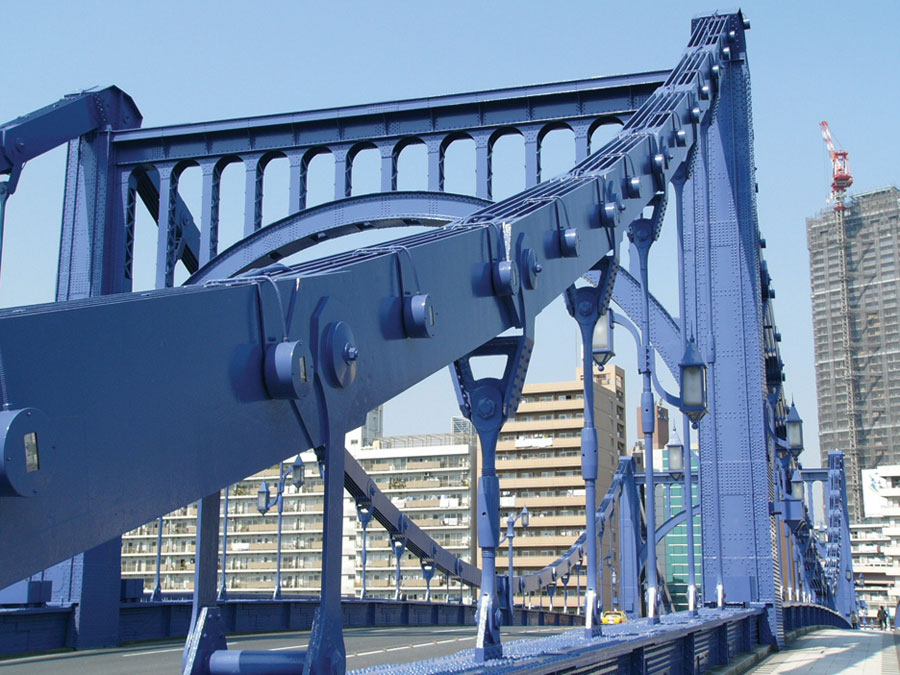FEVE fluoropolymer topcoats are a fluorinated polyurethane-type system. This allows the system to contain not only the advantages of the polyurethane bond such as flexibility and strength, but also allowing for longevity and the ability to withstand environmental deterrents such as UV degradation for years and possibly decades, as seen with the fluorinated portion of the system. But, the fluorinated portion of the system allows for the longevity and the ability to withstand environmental deterrents such as UV degradation for years and possibly decades.

Aura Boulevard Bridge, Australia
Due to this chemistry, the topcoats are used in exterior environments where ovens are not necessary to cure. This allows the coatings to be used on existing bridges directly in the field and new construction as well, resulting in ease of application and reduced maintenance.
FEVE fluoropolymer topcoats have been used in Japan for the last 35 years, where the material was initially designed and then implemented. Over the years, the material has been seen as the superior topcoat system in the bridge market due to its numerous advantages. As a result, most bridges in Japan are coated with this technology. Some of these bridges, which were coated over 30 years ago, still showcase excellent color and gloss retention. Gaining momentum around the globe, this technology can be seen on bridges in the United States as well.

Kiyosu Bridge, Tokyo, Japan
In terms of the benefits of an FEVE fluoropolymer system, the system has a long life-cycle cost advantage. When a bridge is set to recoat, an assessment is done to determine corrosion. If that damage exists, blasting may be necessary, the extent of which depends on the level of corrosion. Blasting can be a hefty potential cost in terms of labor, containment, and the possible environmental impact.

Hell Gate Bridge, New York
Additionally, an FEVE fluoropolymer system requires little maintenance due to how minimally they degrade over time. The system does not collect an abundance of dirt or airborne contaminants and resists corrosion. This can also be seen in more architectural applications where the system may require only a simple water wash versus a pressurized cleaning solution.

Skydance Bridge, Oklahoma City, OK
What is unique to fluoropolymer systems is the integrated carbon-fluorine bond that allows for corrosion resistance and other essential performance qualities. Specifically, the carbon-fluorine bond is resistance to photo-chemical degradation which is degradation from sunlight. This ability to translated in the coating’s color and gloss retention, which remains unchanged for decades. The system also serves as a barrier to resist water which protects a bridge from corrosion. Providing a dual-advantage of maintaining aesthetic properties and resisting corrosion.

Blue Bridge, Grand Rapids, MI
Although a standard exists for the construction of roads and bridges to ensure safety, in the United States we do not have a current coatings standard for performance. This allows for each state, or DOT, to determine their own standards which is determined using a Qualified Product List or QPL. Some states have adopted an NTPEP which sets standards to replace the QPL, but no national standard exists. In order to specify a system for bridges, working with the DOT, the system must be on the designated QPL or NTPEP. In some cases, the DOT can enact a special provision for a uniquely specified coating system, allowing the DOT the ultimate decision to choosing a system.

Akashi Kaikyo Bridge, Japan
Lastly, due to the FEVE fluoropolymer being just the polymer, it is available in various forms. The forms include organic solvents, water, and solid form or flake-grade, which can each
be used to make different types of coating systems. One way to achieve a low VOC coating is by using a water-based system, which are FEVE resins in a water matrix.

Categories Bridges
We are interested to procure the all grades of FEVE coatings like organic solvents dilutable & water-based dispersion for transparent applications, please guide us on how to get this product here in Dubai, U.A.E. ? Awaiting your positive immediate response. Thanks.
For product information in Dubai please email Ben.runhaar@agcce.com as this representative handles the Middle East. Thank you